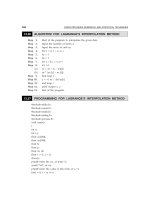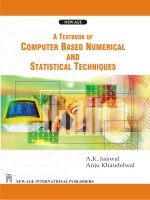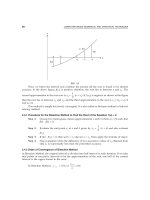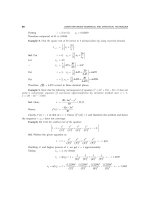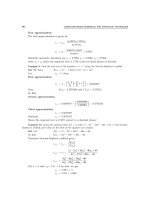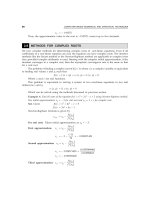A textbook of Computer Based Numerical and Statiscal Techniques part 37 doc
Bạn đang xem bản rút gọn của tài liệu. Xem và tải ngay bản đầy đủ của tài liệu tại đây (121.32 KB, 10 trang )
346
COMPUTER BASED NUMERICAL AND STATISTICAL TECHNIQUES
()
()
1.07152 0.075
1.07152 0.025
1.07152 0.075
−
=+
+
1.09324=
⇒
4
1.09324
y =
at
()
40
4 0 4 0.025 0.1
xx h
=+=+× =
Hence,
(0.1)
1.0932
y =
. Ans.
Example 18. Given
dy
xy
dx
=+
with initial condition y(0) = 1. Find y(.05) and y(.1) correct to 6
decimal places.
Sol. Using Euler’s method, we obtain
()
()
0
110 00
,
yyyhfxy==+
= 1
()
.05 0 1 1.05
++=
We improve
1
y
by using Euler’s modified method
()
()
()
1
0
00011
1
,,
2
h
yy fxyfxy
=+ +
()( )
.05
1 0 1 .05 1.05
2
=+ + + +
1.0525.=
()
()
()
=+ + + +
2
1
.05
1 0 1 .05 1.0525
2
y
=1.0525625
()
()( )
3
1
.05
1 0 1 .05 1.0525625
2
y
=+ + + +
1.052564=
()
()( )
=+ + + +
4
1
.05
1 0 1 .05 1.052564
2
y
1.0525641=
.
Since,
() ()
34
11
1.052564
yy==
correct to 6 decimal places. Hence we take
1
1.052564
y =
i.e., we
have
()
.05 1.052564y
=
Again, using Euler’s method, we obtain
()
()
==+
0
21 11
2
,
yyyhfxy
()
1.052564 .05 1.052564 .05
=+ +
1.1076922.=
We improve
2
y
by using Euler’s modified method
()
()()
=+ ++ +
1
2
.05
1.052564 1.052564 .05 1.1076922 .1
2
y
1.1120511.=
()
()()
2
2
.05
1.052564 1.052564 .05 1.1120511 .1
2
y
=+ ++ +
1.1104294.=
NUMERICAL SOLUTION OF ORDINARY DIFFERENTIAL EQUATION
347
()
()()
=+ ++ +
3
2
.05
1.052564 1.052564 .05 1.1104294 .1
2
y
1.1103888.=
()
()()
=+ ++ +
4
2
.05
1.052564 1.052564 .05 1.1103888 .1
2
y
1.1103878.=
()
()()
=+ ++ +
5
2
.05
1.052564 1.052564 .05 1.1103878 .1
2
y
1.1103878.=
Since,
() ()
45
22
1.1103878,
yy==
correct to 7 decimal places. Hence, we take
2
1.1103878.
y =
Therefore, we have
()
.1 1.110388,y
=
correct to 6 decimal places. Ans.
Example 19. Find y(2.2) using Euler’s method for
2
,
dy
xy
dx
=−
where y(2) = 1. (Take
.1h=
)
Sol. By Euler’s method, we obtain,
()
()
()()
2
0
10 00
1
, 1 .1 2 1 .8.
yyyhfxy==+ =+− − =
This value of
1
y
is improved by using Euler’s modified method
()
()
()
()
10
0001
11
,,
2
h
yy fxyfxy
=+ +
() ( )( )
{}
=+ − +−
22
0.1
1 2 1 2.1 .8
2
.8328=
Similarly
()
() ( )( )
{}
222
1
0.1
1 2 1 2.1 .8328
2
y =+ − +−
.8272=
()
() ( )( )
{}
22
3
1
0.1
1 2 1 2.1 .8272
2
y =+ − +−
.8281=
()
() ( )( )
{}
22
4
1
0.1
1 2 1 2.1 .8281
2
y =+ − +−
=.8280
()
() ( )( )
{}
22
5
1
0.1
1 2 1 2.1 .8280
2
y =+ − +−
= .8280
Since
() ()
45
11
0.8280.
yy==
Hence, we take
1
.828
y =
at
1
2.1
x =
Now, if
2
y
is the value of
y
at
2.2.x =
Then, we apply Euler’s method to compute
()
2.2 ,y
i.e., we obtain
()
()
0
21 11
2
,
yyyhfxy==+
()()
2
.828 .1 2.1 .828
=+−
= .68402
348
COMPUTER BASED NUMERICAL AND STATISTICAL TECHNIQUES
Now, using Euler’s modified formula, we obtain
()
()()()( )
221
2
0.1
.828 2.1 .828 2.2 .68402
2
y
=+ − +−
.70454=
()
()()( )
=+ − +−
22
2
2
0.1
.828 ( 2.1) .828 2.2 .70454
2
y
.70141.=
()
()()()( )
22
3
2
0.1
.828 2.1 .828 2.2 .70141
2
y
=+ − +−
.70189.=
()
()()()( )
22
4
2
0.1
.828 2.1 .828 2.2 .70189
2
y
=+ − +−
.70182=
()
()()()( )
22
5
2
0.1
.828 2.1 .828 2.2 .70182
2
y
=+ − =−
.70183=
Since,
() ()
45
22
.7018
yy==
, correct to 4 decimal places.
Hence, we have
()
2.2 .7018.y
=
Ans.
Example 20. Find y(.2) and y(.5) Given
()
10
dy
=log x+y
dx
with initial condition y = 1 for x = 0.
Sol. Let
() ( )
10
,log
dy
fxy x y
dx
== +
and
.2h =
By Euler’s formula, we have
()
()
0
10 00
1
,
yyyhfxy==+
()
1.2log01 1.
=+ + =
Now, we improve this value by using Euler’s modified formula and thus we obtain
()
()
()
()
10
0001
11
,,
2
h
yy fxyfxy
=+ +
() ( )
{}
0.2
1log01log.21
2
=+ + = +
1.0079=
()
() ( )
{}
2
1
0.2
1 log 0 1 log .2 1.0079
2
y =+ + + +
1.0082=
()
() ( )
{}
3
1
0.2
1 log 0 1 log .2 1.0082
2
y =+ + + +
1.0082=
NUMERICAL SOLUTION OF ORDINARY DIFFERENTIAL EQUATION
349
Since,
() ()
23
11
1.0082
yy==
. Hence, we take
1
1.0082
y =
at
.2x=
, i.e.,
()
.2 1.0082y
=
. Ans.
Again using Euler’s formula, we obtain
()
()
0
21 11
2
y yyhfxy==+ +
()
1.0082 0.3 log 0.2 1.0082 1.0328
=+ + =
To improve
2
y
, we use Euler’s modified formula and we obtain
y
(1)
2
()()
=+ +++
0.3
1.0082 log 1.0328 .5 log .2 1.0082
2
1.0483=
()
()()
2
2
0.3
1.0082 log 1.0483 .5 log .2 1.0082
2
y
=+ + +
1.049=
()
()( )
=+ +++
3
2
0.3
1.0082 log 1.049 .5 log .2 1.0082
2
y
1.0490=
Since
() ()
32
22
1.0490,
yy==
we take
2
1.0490
y =
, i.e.,
()
.5 1.0490y
=
. Ans.
Example 21. Using Euler’s modified method, compute y(0.1) correct to six decimal figures, where
2
dy
xy
dx
=+
with y = .94 when x = 0.
Sol. By Euler’s method, we have
()
()
0
10 00
1
,
yyyhfxy==+
()
.94 .1 0 .94
=+ =
1.034=
Now, we improve y
1
by using Euler’s modified formula and we obtain
()
()
()
()
10
0001
11
,
2
h
yy fxyfxy
=+ +
=.94 +
01
2
0 94 1 1 034
2
.
++ +
bg
a
f
{}
= 1.0392
y
(2)
1
()
()
{}
2
0.1
.94 0 .94 .1 1.0392
2
=+ + + +
=1.03946
()
()
()
{}
23
1
0.1
.94 0 .94 .1 1.03946
2
y
=+ + + +
1.039473=
()
()
()
{}
2
4
1
0.1
.94 0 .94 .1 1.039473
2
y
=+ + + +
1.0394737=
350
COMPUTER BASED NUMERICAL AND STATISTICAL TECHNIQUES
Since,
() ()
34
11
1.039473,
yy==
correct to 6 decimal places
Hence, we have
()
.1 1.039473.y
=
Ans.
Example 22. Using Euler’s modified method, solve numerically the equation
dy
xy
dx
=+
with
y(0) = 1 for 0 ≤ x ≤ 0.6, in steps of 0.2.
Sol. The interval
0.2h =
By Euler’s method, we obtain
()
()
0
10 00
1
,
yyyhxy==+
()
1 0.2 0 1 1.2.
=+ + =
The value of
()
0
1
y
, thus obtained is improved by modified method.
()
()
()
()
1
0001
11
,,
2
n
n
h
yyfxyfxy
+
=+ +
By considering n = 0, we obtain
y
1
(1)
= y
0
+
h
2
BN O BN O(,) (,)
00 11
+
()()
0.2
1010.21.2
2
=+ + + +
1.2295=
By considering
1n=
, we obtain
()
()()
2
1
0.2
1 0 1 0.2 1.2295
2
y
=+ + + +
1.2309.=
By considering
2n=
, we obtain
()
()()
=+ + + +
3
1
0.2
1 0 1 0.2 1.2309
2
y
1.2309.=
Since
() ()
23
11
1.2309
yy===
. Hence, we take
1
1.2309
y =
at
0.2x =
and proceed to compute
y
at
0.4x=
.
Again, applying Euler’s method, we obtain
()
()
0
2
2
1.2309 0.2 0.2 1.2309 1.49279
yy== + + =
Now, we apply modified method for more accurate approximations and we obtain
()
()()
1
2
.2
1.2309 2 1.2309 0.4 1.49279
2
y
=++ ++
1.52402=
()
()()
2
2
.2
1.2309 2 1.2309 0.4 1.52402
2
y
=++ ++
1.525297=
NUMERICAL SOLUTION OF ORDINARY DIFFERENTIAL EQUATION
351
()
()()
3
2
.2
1.2309 2 1.2309 0.4 1.525297
2
y
=++ ++
1.52535=
()
()()
4
2
.2
1.2309 .2 1.2309 0.4 1.52535
2
y
=+ ++
1.52535=
Since,
() ()
34
22
1.52535
yy==
. Hence, we take
2
1.52535
y =
at
0.4x=
. To find the value of
()
3
yy
=
for
0.6x=
, we apply Euler’s method to have
()
()
== + +
0
3
3
1.52535 .2 4 1.52535
yy
= 1.85236
For better approximations, we use Euler’s modified formula and we obtain
()
()()
=++ ++
1
3
.2
1.52535 .4 1.52535 0.6 1.85236
2
y
1.88496=
()
()()
2
3
.2
1.52535 .4 1.52535 0.6 1.88496
2
y
=++ ++
1.88615=
()
()()
3
3
.2
1.52535 .4 1.52535 0.6 1.88615
2
y
=++ ++
1.88619=
()
()()
=++ ++
4
3
.2
1.52535 .4 1.52535 0.6 1.88619
2
y
1.88619,=
correct to 5 decimal places.
Since,
() ()
34
33
1.88619.
yy==
Hence, we take
1.88619y =
at
0.6x=
. Ans.
PROBLEM SET 7.1
1. Solve by Taylor’s method,
()
,01yx yy
′′′′′
=+ =
. Computer
()
0.1 .y
[Ans. 1.11146]
2. Solve by Taylor’s method,
()
2
;01
dy
x
yy
dx y
=− =
. Also compute
()
0.1y
.[Ans. 1.0954]
3. Given differential equation
2
1
dy
dx
xy
=
+
with
()
44.y
=
Obtain
()
4.1y
and
()
4.2y
by Taylor’s
series method. [Ans. 4.005. 4.0098]
4. Apply Picard’s method to find the third approximation of the solution of
dy
dx
= x + y
2
with
the condition y(0) = 1. [Ans. =
1
3
2
4
3
23
++ + +xx x
]
5. Using Picard’d method, obtain the solution of
()
()
3
1;03
dy
xxyy
dx
=+ =
Compute the value of
()
0.1y
and
()
0.2y
.[Ans. 3.005, 3.020]
352
COMPUTER BASED NUMERICAL AND STATISTICAL TECHNIQUES
6. Solve the following initial value problem by Picard method
y
dy
xe
dx
=
with
()
00y
=
, compute
()
0.1y
.[Ans. 0.0050125]
7. Use Picard’s method to approximate
y
when
0.2,x =
given that
dy
xy
dx
=−
with
()
01y
=
.
[Ans. 0.0837]
8. Use Picard’s method to approximate the value of
y
when
0.1x =
, given that
2
3
dy
xy
dx
=+
with
()
01y
=
.[Ans. 1.12721]
9. Solve by Euler’s method
()
2 0, 0 1, 0.1
dy
yy h
dx
−= = =
and
[0,0.3]x∈
.[Ans. y(0.3) = 0512]
10. Apply Euler’s method to find the approximate solution of
()
,01, 0.1
dy
xyy h
dx
=+ = =
and
[]
0,1x
∈
.[Ans. 3.1874]
11. Obtain by Euler’s modified method for the numerical solution for
()
1y
of
1
dy y
dx x
−
=
+
with
()
32y
=
and
0.1h =
.[Ans. y(1) = 0.94771]
12. Using Euler’s modified method, solve
1
dy
y
dx
=−
with y (0) = 0 in the range
00.2x≤≤
(take
0.1h =
). [Ans. y(0.1) = 0.09524, y(0.2) = 0.1814076]
7.6 RUNGE-KUTTA METHOD
The method is very simple. It is named after two german mathematicians Carl Runge (1856-1927)
and Wilhelm Kutta (1867-1944). These methods are well-known as Runge-Kutta Method. They are
distinguished by their orders in the sense that they agree with Taylor’s series solution upto terms
of h
r
where r is the order of the method.
It was developed to avoid the computation of higher order derivations which the Taylors’
method may involve. In the place of these derivatives extra values of the given function
()
,fxy
are
used.
(i ) First order Runge-Kutta method
Consider the differential equation
()
,
dy
fxy
dx
=
;
()
00
yx y
=
(1)
By Euler’s method, we know that
()
10 00 0 0
,
yyhfxy yhy
′
=+ =+
(2)
Expanding by Taylor’s series, we get
()
2
10 00 0
2!
h
yyxhyy y
′′′
=+=++ +
(3)
It follows that Euler’s method agrees with Taylor’s series solution upto the terms in h. Hence
Euler’s method is the first order Runge-Kutta method.
NUMERICAL SOLUTION OF ORDINARY DIFFERENTIAL EQUATION
353
(ii ) Second order Runge-Kutta method
Consider the differential equation
()
,;
dy
fxy
dx
=
()
00
yx y
=
Let
h
be the interval between equidistant values of
.x
Then the second order Runge-Kutta
method, the first increment in
y
is computed from the formulae
()
()
100
001
2
12
,
,
1
()
2
khfxy
xhyk
khf
ykk
=
++
=
∆= +
Then,
10
xxh=+
()
10 0 12
1
2
yy yy kk
=+∆=+ +
Similarly, the increment in
y
for the second interval is computed by the formulae,
()
()
111
2111
12
,
,
1
()
2
khfxy
khfxhyk
ykk
=
=++
∆= +
and similarly for other intervals.
(iii ) Third order Runge-Kutta method
This method agrees with Taylors’ series solution upto the terms in
3
h
. The formula is as
follows:
()
10 1 2310
1
4;
6
yy k kkxxh
=+ + + =+
where,
()
100
,
khfxy
=
1
200
,
22
kh
khfx y
=++
()
30021
,2
khfxhy kk
=++−
Similarly for other intervals.
(iv) Fourth order Runge-Kutta method
This method coincides with the Taylor’s series solution upto terms of
4
h
.
Consider the differential equation
()
,
dy
fxy
dx
=
with initial condition
()
00
yx y
=
. Let
h
be the interval between equidistant
values of
x
. Then the first increment in
y
is computed from the formulae.
()
100
,
khfxy
=
1
200
,
22
k
h
khfx y
=++
354
COMPUTER BASED NUMERICAL AND STATISTICAL TECHNIQUES
2
300
,
22
k
h
khfx y
=++
()
4003
,
khfxhyk
=++
Then
()
10 1 2 34
1
22
6
yy k k kk
=+ +++
and
10
xxh=+
Similarly, the increment in
y
for the second interval is computed by
()
111
,
khfxy
=
1
211
,
22
k
h
khfx y
=++
2
311
,
22
k
h
khfx y
=++
()
4113
,
khfxhyk
=++
Then,
()
21 1 2 34
1
22
6
yy k k kk
=+ +++
and
21
xxh=+
and similarly for the next intervals.
Runge-Kutta Method for Simultaneous First Order Equations
Consider the simultaneous equations
()
1
,,
dy
f xyz
dx
=
()
2
,,
dy
f xyz
dx
=
With the initial condition
()
00
yx y
=
and
()
00
zx z
=
. Now, starting from
()
000
,,
xyz
,
increments
k
and
l
in
y
and
z
are given by the following formulae:
()
11000
,, ;
khfxyz
=
()
12000
,, ;
l hf xyz
=
11
210 0 0
,,
222
kl
h
khfx y z
=+++
;
11
220 0 0
,,
222
kl
h
lhfx y z
=+++
22
310 0 0
,,
222
kl
h
khfx y z
=+++
;
22
320 0 0
,,
222
kl
h
lhfx y z
=+++
()
410 0303
,,
khfxhykzl
=+++
;
()
420 0303
,,
lhfxhykzl
=+++
Hence,
()
10 1 2 34
1
22 ;
6
yy k k kk
=+ +++
()
10 1 2 34
1
22
6
zz l l ll
=+ +++
To compute
22
,,
yz
we simply replace
()
000
,,
xyz
by
()
111
,,
xyz
in the above formulae.
NUMERICAL SOLUTION OF ORDINARY DIFFERENTIAL EQUATION
355
Example 1. Apply Runge-Kutta Method to solve.
()
1/3
dy
=xy ,y 1 =1
dx
to obtain y(1.1).
Sol. Here,
00
1, 1
xy==
and
0.1h =
. Then, we can find
()
100
,
khfxy
=
()()
1/3
0.1 1 1 0.1
==
1
200
,
22
k
h
khfx y
=++
1/3
0.1 0.1
0.1 1 1 0.10672
22
=+ + =
2
300
,
22
k
h
khfx y
=++
1/3
0.1 0.10672
0.1 1 1 0.10684
22
=+ + =
()
4003
,
khfxhyk
=++
()( )
1/3
0.1 1 0.1 1 0.10684 0.11378
=+ + =
0.11378=
∴
()
()
01234
1
1.1 2 2
6
yykkkk
=+ + + +
()
1
1 0.1 2 0.10672 2 1.0684 0.11378
6
=+ +× +× +
1 0.10682 1.10682=+ =
. Ans.
Example 2. The unique solution of the problem
yxy
′
=−
with y
0
= 1 is
2
/2
x
ye
−
=
.
Find approximately the value of y
(0.2)
using one application of Runge-Kutta method of order four.
Sol. Let
0.2,h =
we have
0
1
y =
when x
0
= 0.
()
100
,
khfxy
=
()
0.2[ 0 1] 0
==
1
200
,
22
k
h
khfx y
=++
()
0.2
0.2 0 1 0 0.02
2
=−+ +=−
2
300
,
22
kh
khfx y
=++
0.2 0.02
0.2 0 1 0.0198
22
=−+ − =−
